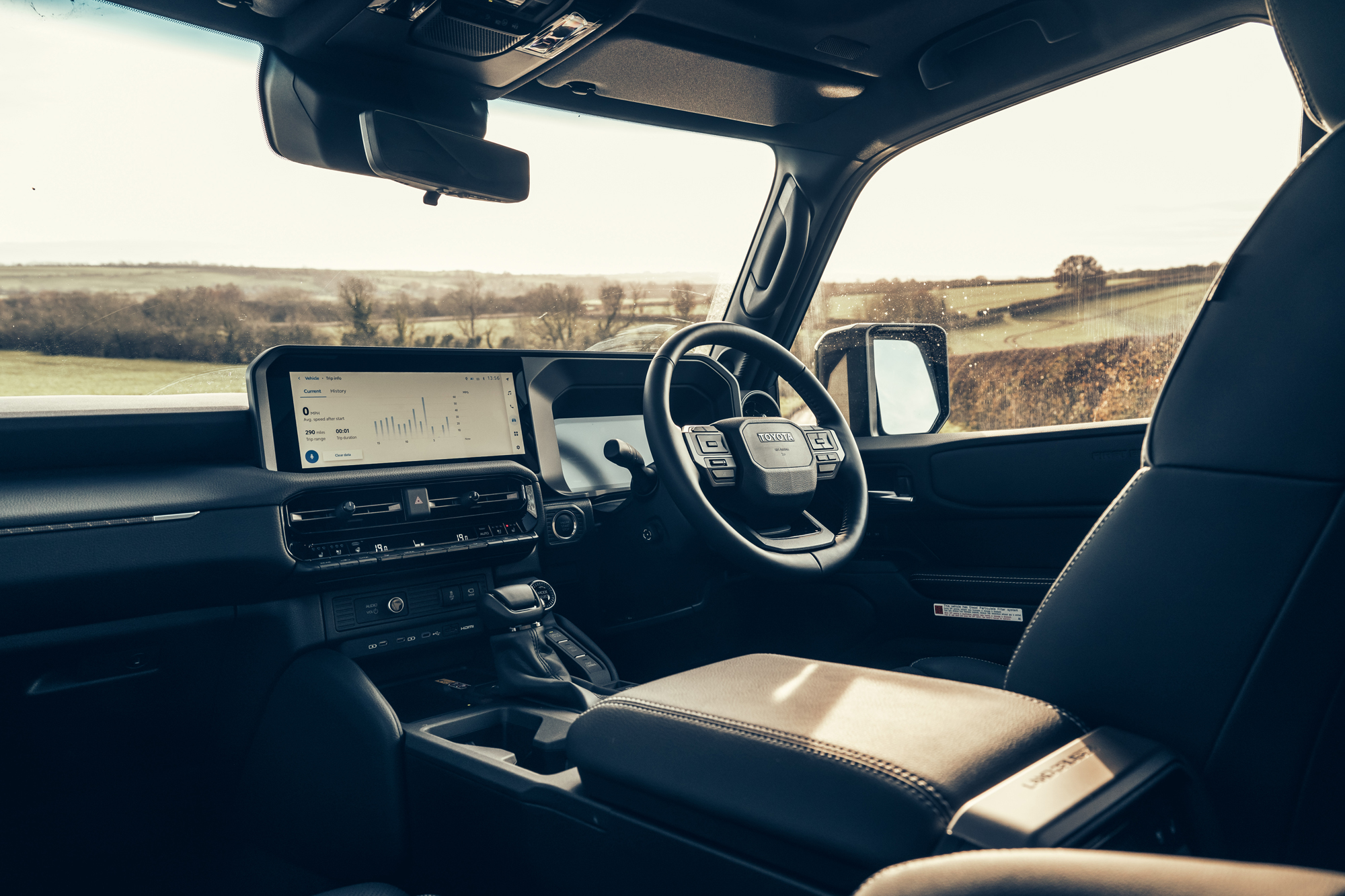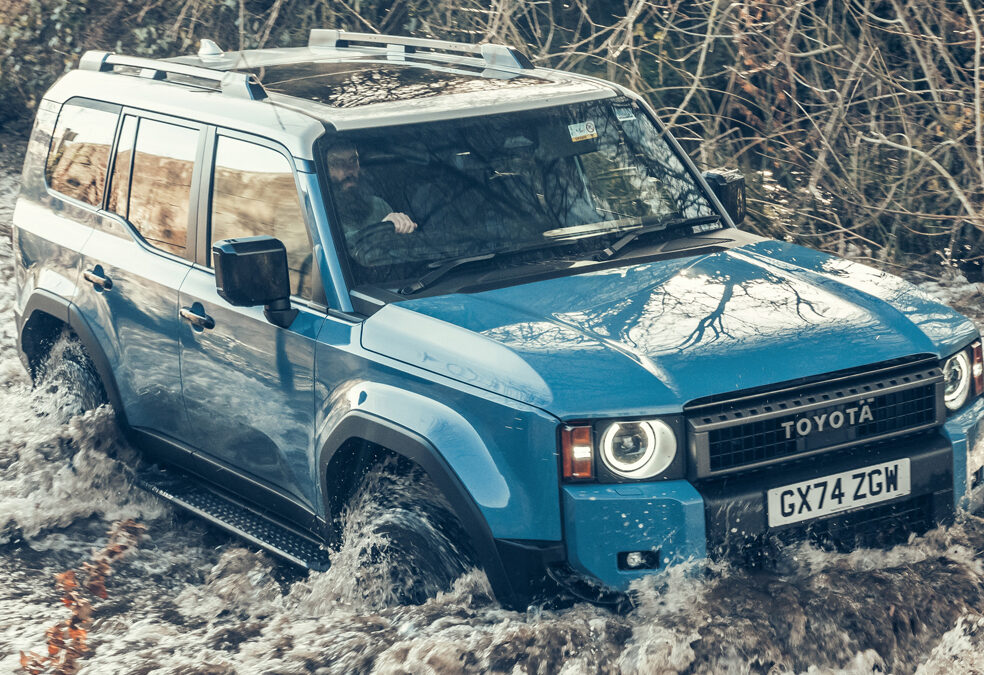
THE GIANT TEST
Land Rover Defender | Toyota Land Cruiser

And the best 4×4 for the end of the world is…
Pessimistic about how long civilisation has left? Then you need a go-anywhere survival vehicle. But do you get the Toyota or the Defender?
Off-roading in someone else’s very valuable car requires a considered blend of aggression and restraint. Go too hard in the wrong places and at best you’ll spill your pumpkin spiced latte. At worst you’ll need a bin bag for the car’s corners and a good story for the insurance paperwork. But fail to go hard enough and you might get stuck, which would be embarrassing in any 4×4, let alone one wearing Land Cruiser or Defender badges. If in doubt, then, give it some power.
Water surges over the Defender’s bonnet, the supercharged V8’s thick-milkshake purr turns to a hungover-bear roar and, as the Wade Sensing display on the touchscreen (sensors detect anything over four inches of standing water, monitoring the rising tide to stop you going in too deep) assures me there’s nothing to worry about (we’re barely troubling a third of the Defender’s 900mm wading depth; the Land Cruiser maxes out at 700mm), we accelerate so effortlessly that the steep climb up the far bank is blitzed on momentum alone, requiring no power whatsoever.
Behind me, like an ‘anything you can do, I can do at least as well’ shadow I just can’t lose, the Land Cruiser follows suit, its glaring round headlights (you can spec rectangular ones for a less retro look) piercing the spray. In fact, the Toyota looks so good in my mirrors I can’t tear my eyes away, its lantern-jawed, geometric design language looking just perfect now that the car’s flanks are caked in winter mud. For so long a trusted tool to do a job, the Land Cruiser’s new look has infinitely broadened its appeal.
‘All it had to do was make it look like a proper Land Cruiser, which it has’

Which begs the question: what took Toyota so long? Most manufacturers must scratch around in their loft for a car they might, on a good day, get away with describing as an icon – ideally without being laughed out of town. Toyota’s been sitting on one for more than half a century. When it comes to legendary 4x4s, Jaguar Land Rover is spoilt rotten, of course, with at least two: the flagship Range Rover and the more utilitarian Defender. And the two cars are solid gold performers, powering JLR to profits of £1.1bn in the first half of 2024, up 25 per cent year-on-year. And that was merely the latest bit of great financial news in a streak running to eight profitable quarters on the bounce. On sale for nearly five years now, the Defender’s popularity shows no sign of waning. JLR can’t build them fast enough, and the appeal of a great-looking, versatile and good-to-drive SUV with the all-terrain capability to breeze any apocalypse is obvious.
Hence the Defender-ification of the Land Cruiser. Toyota’s 4×4 name plate, together with Jeep and the G-Class, in inarguably authentic. All it had to do was make it look like a proper Land Cruiser, which it has, while gently evolving the hardware beneath to give the ladder-framed off-roader more polish on the road. And you know what? It’s worked. Despite some not-messing-about pricing (it costs £74,995 in Invincible guise in the UK; the First Edition, like our test car, is £79,995) Toyota has, after the first wave of UK customer deliveries, been forced to press pause on sales, so strong has demand been. Nice problem to have.
So, what’s it to be? Land Rover or Land Cruiser? What’s the best chunky-looking family wagon for active lifestyles/breezing the zombie apocalypse? To be clear, though, choosing between this actual Land Cruiser and this actual Land Rover is not an £80k dilemma. Yes, you can get a Defender 130 for circa £80k, though we’d recommend the five-seat, two-row 110 with the D350 mild-hybrid diesel.
‘In the Defender you’re swaddled in what feels like several hundred of the world’s finest duvets’

But you can’t get a V8 Supercharged Defender 130 like this one for £80k, sadly. The V8 130 is £116k without options. It’s a lot of money, yes. A 2.7-tonne SUV with the power and torque (493bhp and 450lb ft) to launch 0-62mph in 5.7sec was never going to be cheap. (At 10.9sec, the 202bhp, 369lb ft Toyota takes twice as long.) But in many ways the powertrains perfectly reflect the characters of the cars into which they’re bolted. The Toyota is the more honest and purposeful of the two cars; the Land Rover the polished, luxurious option. And everything else about this Defender makes for a valid comparison.
Back on the road, river water cascading from various orifices like wrecks raised from the sea, these two mud monsters go about things in very different ways on tarmac. In the Defender you’re swaddled in what feels like several hundred of the world’s finest duvets. Road and wind noise are all but absent. Despite its chunky design and durable, rubberised finish in places, the Defender’s cabin feels and smells expensive – certainly more expensive than the Land Cruiser’s. Visibility is superb, adding to the car’s relaxing vibe, and the ride comfort is mostly sensational, the big Land Rover gliding over broken tarmac and farm tracks like a four-wheeled hovercraft. Thank its monocoque structure and air suspension.
There are some inspired little design features in the Defender’s cabin, too. Physical knobs and buttons for the climate control and engine stop/start are a welcome return to common sense, the touchscreen is lag-free and beautiful, whether you’re running Land Rover’s OS or your phone’s, and the rubberised charging pad, which slopes at 45°, is genius, ensuring your phone doesn’t slide about and drop off wireless charging as you drive. (The Land Cruiser solves the issue with little barriers to stop your phone straying too far). Knocking off the more annoying driving assists is straightforward in both cars, using controls on the steering wheels.
‘The Toyota’s ride is fine in isolation but can’t compete with the Defender’s compliance’
In contrast to the Defender’s stunning refinement the Land Cruiser, with its gruff four-cylinder diesel engine, is loud. That said the driving position is every bit of comfortable and the cabin’s similarly unfussy interior design very appealing, though the Toyota’s cockpit feels more cluttered.
First Edition cars also get niceties like full leather and a head-up display but, while there’s much to like here, you’ll need to be a big fan of the noise diesel engines make to be truly happy. The racket is pretty much omnipresent, not least because the eight-speed automatic instantly drops a couple gears for even the smallest of throttle inputs, rather than using its torque (unless you slide the lever over into its manual setting). As such it feels like the thing never really settles down, and you pay a price for that chunky styling in wind noise, too. Like the engine, the battle between the Land Cruiser’s bluff prow and the onrushing atmosphere is not a particularly quiet one.
The Toyota’s ride is fine in isolation but can’t compete with the Defender’s compliance. Perfectly serviceable on the road at speed, the Land Cruiser’s suspension struggles with lumpier back roads, town work and sudden ridges. Off-road, it’s incapable of making a gravel track feel like anything else, whereas the Land Rover gives the sense of it re-surfacing it in real time as you pass.

All of which might suggest the Land Cruiser’s some ill-mannered 4×4 that should stick to the desert (or the mountains, or the moors, or the wherever). That really isn’t the case. Yes, it’s not as smooth nor as civilised as the Defender, and where long drives in the Land Rover are effortless, the Land Cruiser is tiring over extended periods. But the Toyota’s happier on twisting country roads thanks to its more sensible dimensions, less terrifying kerbweight (2.3-2.5 tonnes, depending on spec, versus 2.7) and superior body control.
Up to a point, the Defender’s just fine when driven at a decent clip, gliding through corners, instantly getting back up to speed thanks to the supercharged V8’s velvety punch and putting a smile every time you’re forced to slow down thanks to the gorgeous power and feel of the Brembo brakes. But try to really hustle and the Defender isn’t happy. Which is as it should be, really. The Range Rover, too, has a point at which it draws the line and is a better car for it. Land Rovers risk becoming confused when, like the Range Rover Sport, they chase dynamics.
The Toyota, meanwhile, feels agile and composed, and like a hot hatch by comparison. It tracks faithfully into turns with every nudge at the wheel (its electric power steering is new and, like the ride and engine refinement, is a giant leap over the previous model), summoning impressive grip from its mixed-surface Geolander rubber, even on cold, wet tarmac. And thanks to that super-sensitive kickdown, the Land Cruiser’s off and pulling in the responsive part of its rev range just as soon as you ask it too.
Drive like you left the iron on and the Land Cruiser’s fuel economy dips from 29mpg to 26, and the Land Rover’s – supercharged V8, remember – from 21 to 19… Choose a more sensible Defender engine and you’ll match the Toyota’s economy and lose very little of this V8’s refinement.



Clockwise frop top: Land Rover’s badge of honour; The Discovery takes an unfussy approach; Toyota’s interior is a bit more ‘hands on’
Really don’t care about fuel bills? Then we can’t help but suggest you treat yourself. Its supercharged V8 is not as bombastic as the spec sheet might suggest but again, that’s as it should be. It’s syrupy smooth, utterly charming and powerful enough to give this vast car a compelling turn of speed when you ask for it. The gearbox, however, is the opposite of the Land Cruiser’s trigger-happy set-up. Snoozy to the point of distraction, overtakes and quicker driving require that you work the gorgeous metal shift paddles yourself.
The Defender may be the most utilitarian car Land Rover makes, but it is not – in most specifications – a utilitarian car. Neither, in many ways, is the Toyota, but it has a rugged authenticity to it that fits its rugged good looks perfectly – a mechanical and spiritual honesty you feel you could, over time and road trips and adventures (or more realistically, school runs) fall pretty hard for.
‘This Land Cruiser is yet another example of Toyota getting things very right’
The off-road ability of both is astonishing, with their locking diffs, high- and low-range transmissions – selected by button now, rather than Victorian-era handle – and confidence-boosting systems including terrain select, hill descent control and crawl control.
Both also have a raft of on-road safety systems. In the case of the Toyota that includes Proactive Driving Assist, which slows you down for corners, feeling like an EV switching to a higher level of regen, even when you’re not using cruise control; it’s weird but effective, and you can turn it down or off.
Both cars are big on space. At 4920mm long, the Toyota feels almost cosy after the stadium-sized 130. But in reality it’s ridiculously roomy, with acres of legroom and a 1063-litre boot you’ll love stuffing with dogs, camping kit and biscuits. We much prefer the Land Cruiser’s power-opening conventional bootlid, too, as opposed to the Defender’s macho but cumbersome side-hinged back door.
In its seven- or eight-seat configurations, the vast (it’s 5.358 metres long if you include the spare wheel) 130 is the nicest minibus you’ll ever sit in. A joy in any one of its three rows, the seven-seat set-up makes for a nice gap between the second-row seats, so back-row occupants can slink through without having to fold a seat out of the way first.



Verdict
The Zombies don’t stand a chance

This Land Cruiser is yet another example of Toyota getting things very right. Desirable, great looking and crushingly competent off-road, its road manners are night-and-day better than both the Land Cruisers of legend and this model’s immediate predecessor. Fun to drive and composed, you could now buy one, never use it off-road and not feel like you’d entirely missed the point.
But the Defender remains a formidable rival. It’s a more aloof handler than the terrier-like Land Cruiser, if that matters to you, but its layers of additional refinement are hard to argue with, particularly on the kind of long family road trips at which these cars excel. That diesel engine is just too busy to make a relaxing driving companion. A version of the Hilux’s 48-volt hybrid diesel powertrain is on the way, and it might ease the issue, by boosting the diesel where it can and smoothing its rougher edges. Until then we’ll take a Defender, with the V8 if we’re excessively (and hypothetically) wealthy or the D350 diesel if only moderately so. Not that money will matter when the zombies come, I guess.
1st
Land Rover Defender
Formidable refinement and astonishing versatility
2nd
Toyota Land Cruiser
Agile and nimble next to the Defender, but that engine’s refinement can irk

Facts & Figures | Land Rover Defender
What’s the line-up?
The current Defender is available as the three-door 90 (priced from £59,73), the longer five-door 110 and the longer still 130. There’s a choice of petrol, diesel and plug-in hybrid powertrains (not all available with ever body style), and an even bigger choice of spec levels and options, available individually or in packs. There are also Hard Top versions with removable roof panels, and there’s the hardcore Octa version. Ours is a Land Rover Defender 130 V8 Supercharged
Data
Price £115,865 (£126,310 as tested)
Powertrain 5000cc 32v supercharged V8, eight-speed automatic, all-wheel drive
Performance 493bhp @ 6000rpm, 450lb ft @ 2500rpm, 5.7sec 0-62mph, 149mph
Weight 2660kg
Efficiency 19.7mpg (official), 19.2mpg (tested), 390-mile range (official), 380-mile range (tested), 324g/km CO2
Length/width/height 5358mm/2008mm/1970mm
Boot capacity 389 litres (with seven seats)

Facts & Figures | Toyota Land Cruiser
What’s the line-up?
As ever with the long-running Land Cruiser, the same name is used for slightly different models in different markets. Here in the UK, this first all-new Land Cruiser since 2011 is currently available with a 2.8-litre diesel engine, in a choice of First Edition trim like our test car – except that’s all sold out – and the slightly less retro Invincible, priced from £24,995. Both are seven-seaters. A mild-hybrid engine should be available in 2025.
Data
Price £79,995 (£79,995 as tested)
Powertrain 2755cc 16v turbodiesel four-cylinder, eight-speed automatic, all-wheel drive
Performance 201bhp @ 3000rpm, 369lb ft @ 1600rpm, 10.9sec 0-62mph, 102mph
Weight 2550kg
Efficiency 26.6mpg (official), 27.4mpg (tested), 279g/km CO2, 527-mile range (official), 540-mile range (tested)
Length/width/height 4920mm/1980mm/1935mm
Boot capacity 1063 litres



